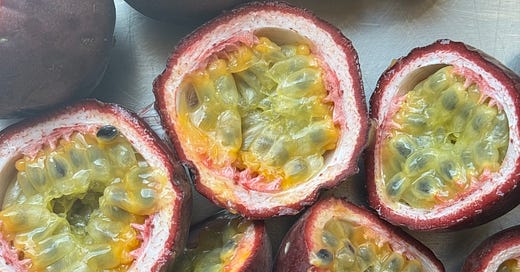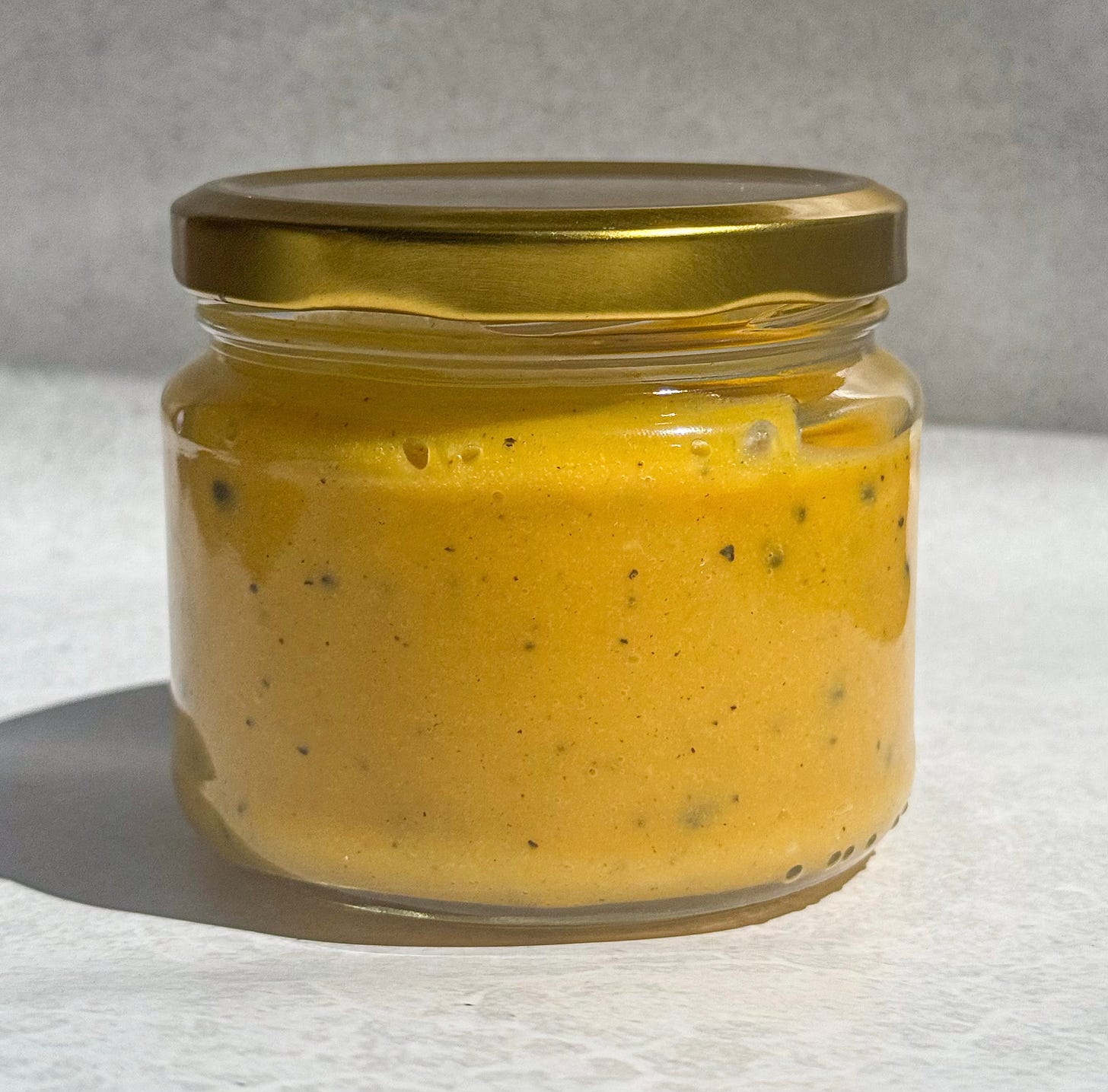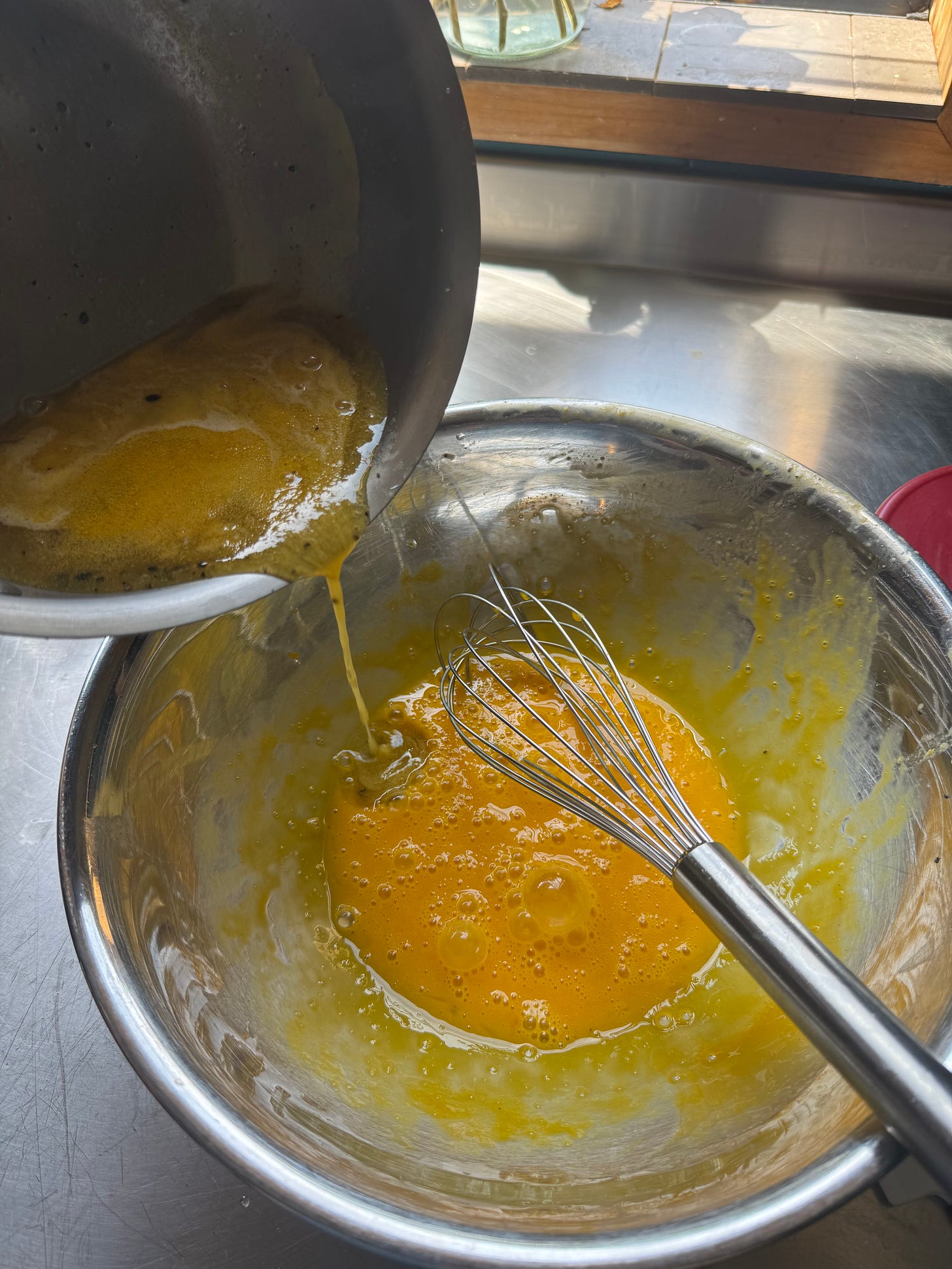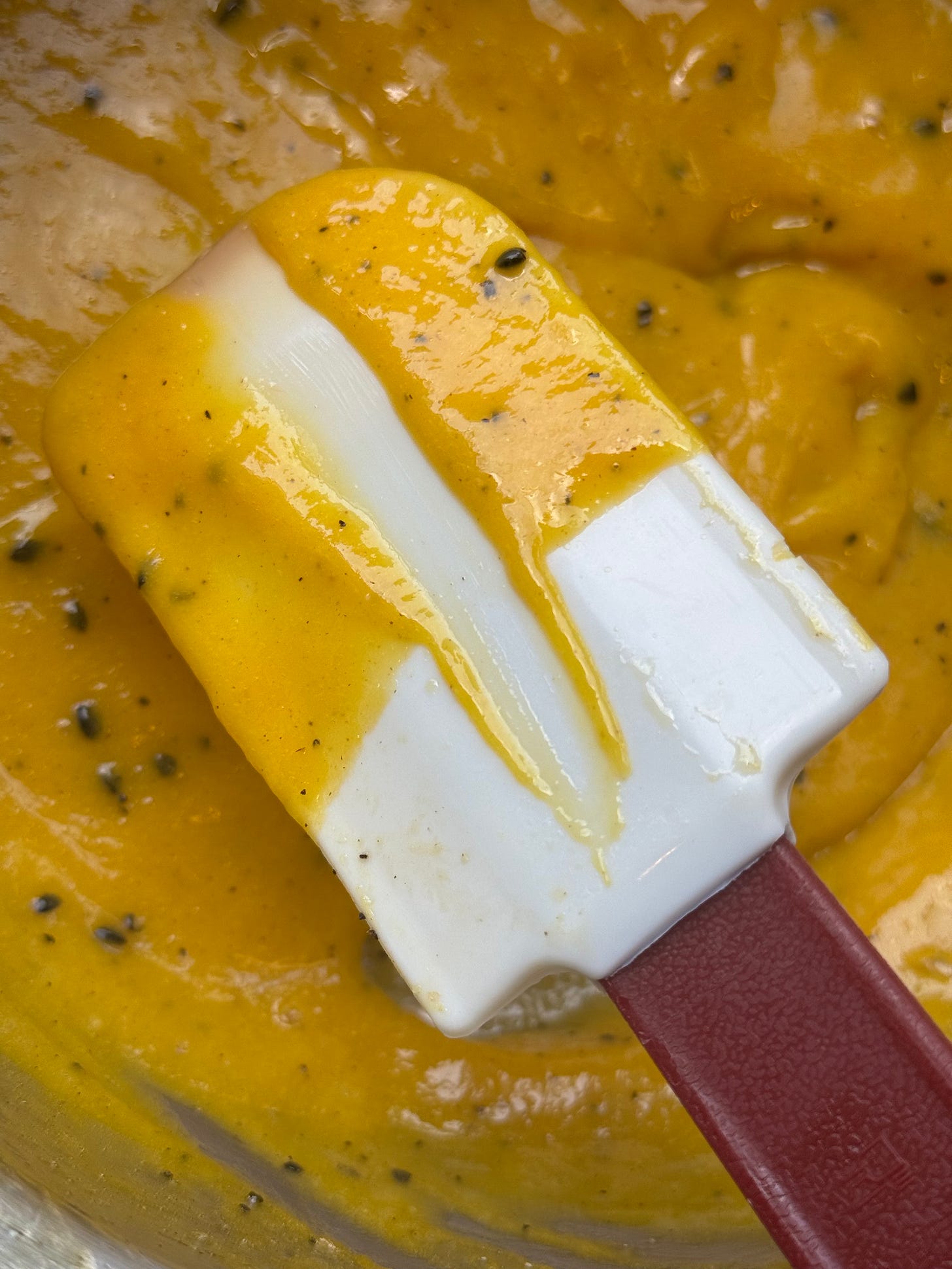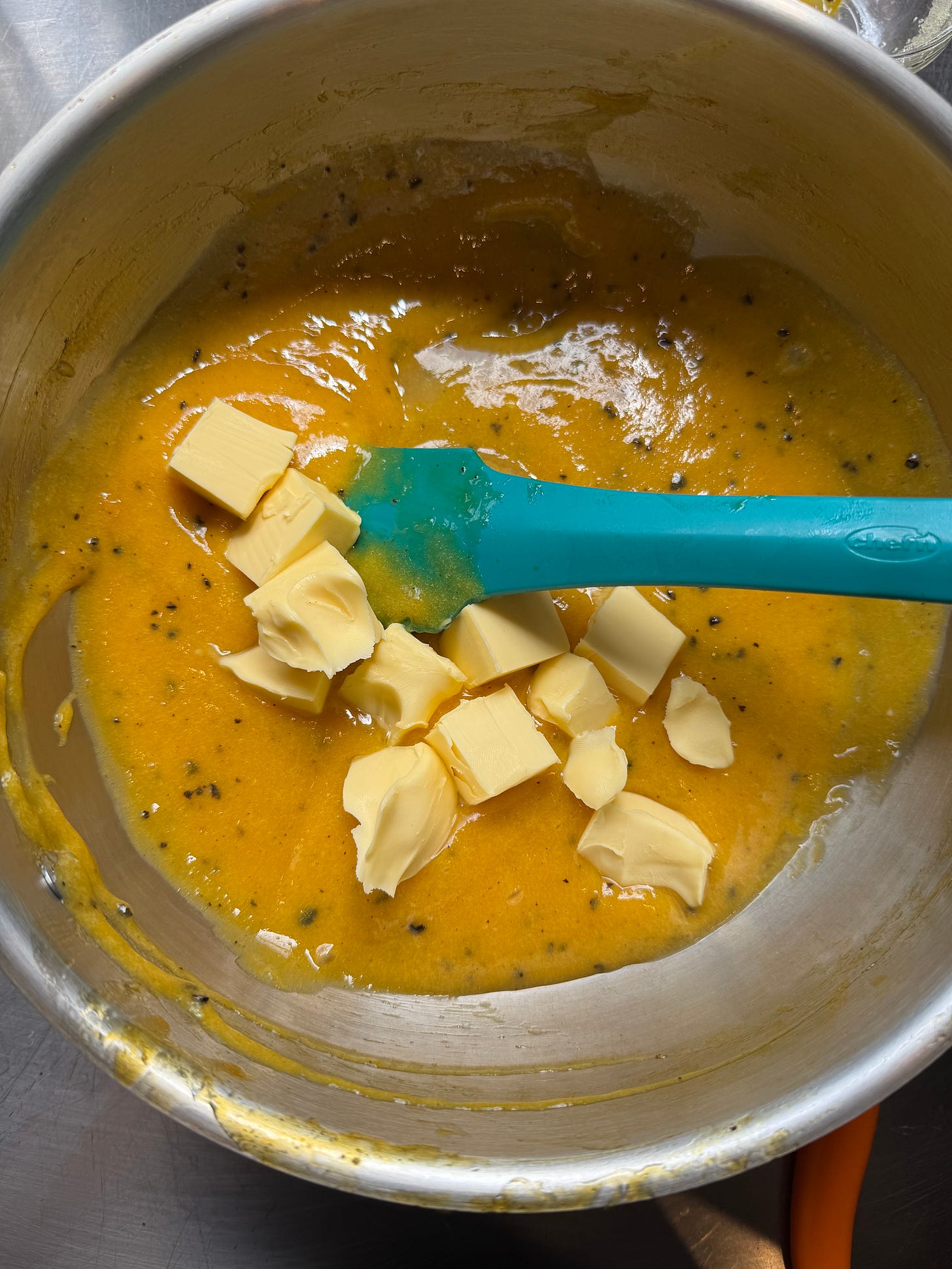Passionfruit curd
A tangy, creamy & speckled passionfruit curd that can be used in lots of ways.
It is passionfruit season in New Zealand and I was recently asked by a friend who has an abundance of passionfruit growing in her backyard what to do with it when you have so much. She has been eating it straight and spooning it over ice cream, which we agreed while delicious can get a bit boring. I also just ordered a 2.5kg box so have a lot to get through. I was thinking about how to use it, and what instantly came to mind was passionfruit curd. I have previously made it as a filling for a coconut layer cake to go alongside coconut whipped ganache so I already had an old recipe to tinker with, plus passionfruit curd is a great base to utilise on other desserts. Some ways to use this curd will be coming soon….
I love passionfruit curd because it has a slight sweetness that lemon curd doesn’t have and gives very tropical vibes which is rare for New Zealand. It is made in the same way as a lemon curd, using a base of eggs, sugar and butter plus I sometimes add gelatine when I need a more stable curd that supports itself in cakes.
There are two popular ways I have seen to make curd, one involves adding all your fruit juice, sugar, eggs and butter into a bowl and cooking it over a Bain Marie until thickened, the other (and my preferred) is cooking it like a creme patisserie by heating your fruit and sugar together then tempering the eggs and cooking out till thickened and adding the butter afterwards. I find this method much quicker and produces a better textured firmer curd. However, you can do either.
INGREDIENTS
55g whole egg (approx 1 large egg)
55g yolks (approx 3 yolks) *(this is approx the separation of egg you want, but if you have 65g whole egg and 45g yolk that’s fine, you want 110g total)
110g seedless passionfruit pulp **(I blitz approx 180g passionfruit pulp and strain out the seeds, then weigh out 110g and add back 1 tsp of the blitzed seeds for a speckled look)
30g lemon juice
70g sugar
70g butter, cold and diced into 2cmish pieces (if slightly less than cold/room temp that’s fine, but don’t want soft squishy butter)
1/2 tsp kosher salt
3 g gelatine bloomed in 15 g water (optional, I use it when using the curd for a layer cake as gives it a firmer more stable set)
METHOD:
Put the passionfruit pulp, lemon juice, sugar and salt in to a medium sized pot and cook over low heat until the sugar is dissolved. Meanwhile, whisk together the eggs and egg yolks until cohesive in a large metal bowl.
A note on cooking method: You can cook the curd over a Bain Marie if you are worried about curdling as this is a much gentler way of cooking, but it will take a bit of time. Alternatively, if you are a confident curd maker you can cook this in a pot directly over low heat, but you need to watch this and stir the entire time it is cooking, the bonus is that it will come together very quickly! Just note when choosing your method that because there are seeds in the curd that we want to keep it isn’t strained so any bits of egg that form on the bottom won’t be sieved out.When the sugar is dissolved and the passionfruit mixture is warm, temper the eggs with a good glug (approx 1/4 cup) of the passionfruit mix while whisking. Tempering essentially means adding a little bit of the hot liquid into the egg mixture while whisking to warm the eggs and prevent curdling when you add the rest of the hot mix in. Then add the rest of the hot passionfruit mixture, whisking while you add it or straight after you add.
If you are using a Bain Marie, fill the pot you just used with water about an inch or two deep, but not so full that the base of the bow touches the water when you put it on top, then place the bowl over the pot and cook over low/medium heat while stirring with a spatula.
If you are using the pot, pour the mixture back into the pot and set it over a low heat and begin stirring with a spatula.Cook the curd mixture until it thickens and coats the back of a spoon, or until it recaches 82-83C on an instant read thermometer. I like to start with a rubber spatula but once it starts thickening I switch to a whisk to prevent sticking on the bottom. Remove the curd from the heat and, if using, add the bloomed gelatine. Now leave the curd to cool for 5ish minutes before adding the butter. Adding the butter once it has cooled was something I learnt in pastry school which you don’t see in a lot of recipes, but it helps with the set making the curd nice and smooth. Although if you add your butter while cooking I am sure it will still work out perfectly fine!!
Once the curd has cooled slightly and is about 40c, add your butter a couple of cubes at a time whisking to incorporate before adding the next (don’t be like me below and add it all at once, this is bad practice!). If your mixture has cooled too much the butter won’t incorporate so just gently warm over the Bain marine until slightly hot to the touch. Once all the butter has been incorporated taste the curd. If it is not quite tangy enough add a 1/4 tsp of citric acid.
Pour into a jar or container and leave to cool in the fridge for about 3 hours before using. If you add gelatine the texture will be quite firm, so give it a good stir with a rubber spatula before using. The curd will last for around a week, but much longer in the freezer.

